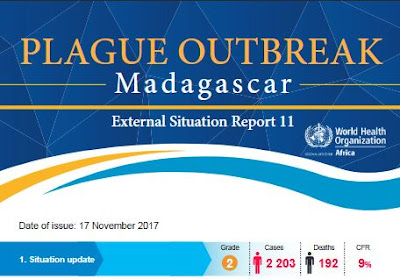#12,906
Although the number of `suspected, probable, and confirmed' plague cases reported from Madagascar continues to rise, the momentum of their plague epidemic continues to decline (see epi curve below) with no new laboratory confirmed infections in nearly two weeks.
That said, additional lab-confirmed cases are not only possible - they are expected - as Madagascar's plague season often runs into April. Despite the breathless, often hyperbolic coverage by the tabloids, the overall trend is encouraging.
At least for now.
Some excepts from the latest WHO Sitrep - with numbers current through Nov15th - follow:
WHO continues to support the Ministry of Public Health and other national authorities in Madagascar to monitor and respond to the outbreak of plague. From 6 to 15 November 2017, 149 probable (12) and suspect (137) cases of plague were reported to WHO. The date of onset of the last case of bubonic plague was 29 October and the last confirmed case of pneumonic plague was reported on 6 November.(SNIP)
From 1 August to 15 November 2017, a cumulative total of 2 203 confirmed, probable and suspected cases of plague, including 192 deaths (case fatality rate 9%), have been reported from 56 of 114 (49%) districts in Madagascar. Analamanga Region in central Madagascar has been the most affected, with 68% of all recorded cases. Since the beginning of this outbreak, the vast majority of cases have been treated and have recovered. As of 15 November 2017, only 6 people were hospitalized for plague. There has been no international spread outside the country.
The majority of the reported cases (1 705, 77%) have been clinically classified as pneumonic plague, 321 have been classified as bubonic plague (15%), one was septicaemic, and 176 have not yet been classified (further classification of cases is in process). Eighty-one healthcare workers have had illness compatible with plague, none of whom have died.
Of the 1 705 clinical pneumonic cases, 372 (22%) have been confirmed, 599 (35%) are probable and 734 (43%) remain suspected (additional laboratory results are in process). Twenty-five isolates of Yersinia pestis have been cultured and are sensitive to all antibiotics recommended by the National Plague Control Program.
Of the 7 270 contacts identified during this outbreak, 99% (7166) have completed their 7-day follow up and a course of prophylactic antibiotics, and eleven contacts have developed symptoms compatible with plague and became suspected cases. On 15 November 2017, 31 out of 33 (94%) contacts currently under follow-up were reached and provided with prophylactic antibiotics.
Plague is endemic on the Plateaux of Madagascar, including Ankazobe District, where the current outbreak originated. A seasonal upsurge, predominantly of the bubonic form, usually occurs yearly between September and April. This year, the plague season began earlier than usual. The current outbreak is predominantly pneumonic and is affecting both endemic and non-endemic areas, including major urban centres such as Antananarivo (the capital city) and Toamasina (a port city).
Current risk assessment
The number of new plague cases in Madagascar has steadily declined since mid-October. From 6 to 15 November 2017, 149 probable (12) and suspect (137) pneumonic cases, 18 bubonic cases and 8 unspecified cases of plague have been reported to WHO. No confirmed cases have been reported since 6 November and, to date, no cases of plague have been reported outside of Madagascar.
While the number of new cases and hospitalizations are declining, evidence suggests that the epidemic phase of the outbreak is ending. However, WHO anticipates plague cases to be reported until the endemic plague season ends in April 2018.
Based on available information and response measures implemented to date, the potential risk of further spread of plague at national level remains high. The risk of international spread is mitigated by the short incubation period of pneumonic plague, implementation of exit screening measures and advice to travellers to Madagascar, and scaling up of preparedness and operational readiness activities in neighbouring Indian Ocean islands and other southern and east African countries. The overall global risk is considered to be low.
WHO is re-evaluating the risk assessment based on the evolution of the outbreak and information from response activities.

